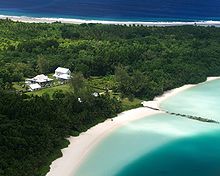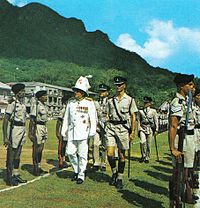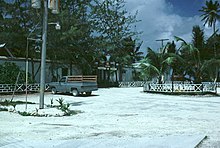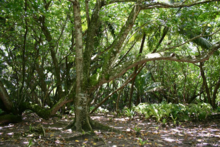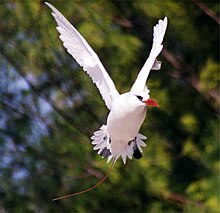Diego Garcia
[citation needed] The island is also labelled "Don Garcia" on Mercator's Nova et Aucta Orbis Terrae Descriptio ad Usum Navigatium Emendate (Duisburg 1569).
The Nova Totius Terrarum Orbis Geographica of Hendrik Hondius II (Antwerp 1630) repeats Wright's use of the name, which is then proliferated on all subsequent Dutch maps of the period, and to the present day.
[20] In 1942, the British opened RAF Station Diego Garcia and established an advanced flying boat unit at the East Point Plantation, staffed and equipped by No.
[24] In the early 1960s, the UK was withdrawing its military presence from the Indian Ocean, not including the airfield at RAF Gan to the north of Diego Garcia in the Maldives (which remained open until 1976), and agreed to permit the United States to establish a naval communication station on one of its island territories there.
According to Stuart Barber—a civilian working for the US Navy at the Pentagon—Diego Garcia was located far away from any potential threats, it was low in a native population and it was an island that was not sought after by other countries as it lacked economic interest.
[35] In the early 1970s, setbacks to United States military capabilities in the region including the fall of Saigon, victory of the Khmer Rouge in Cambodia, the closure of the Peshawar Air Station listening post in Pakistan and Kagnew Station in Eritrea, the Mayaguez incident, and the build-up of Soviet naval presence in Aden and a Soviet airbase at Berbera, Somalia, caused the United States to request, and the UK to approve, permission to build a fleet anchorage and enlarged airfield on Diego Garcia,[36] and the Seabees doubled the number of workers constructing these facilities.
[37] On 23 June 2017, the United Nations General Assembly (UNGA) voted in favour of referring the territorial dispute between Mauritius and the UK to the International Court of Justice (ICJ) in order to clarify the legal status of the Chagos Islands archipelago in the Indian Ocean.
[43][7] In June 2020, a Mauritian official offered to allow the United States to retain its military base on the island if Mauritius succeeded in regaining sovereignty over the Chagos archipelago.
US president Joe Biden welcomed the agreement, saying that it was a "clear demonstration that through diplomacy and partnership, countries can overcome long-standing historical challenges to reach peaceful and mutually beneficial outcomes".
[56][better source needed] During combat operations from the atoll against Afghanistan (2001–2006) and Iraq (2003–2006), a number of allied militaries were based on the island including Australian,[57] Japanese, and the Republic of Korea.
[59] In 2004, US Navy recruitment literature described Diego Garcia as being one of the world's best-kept secrets, boasting great recreational facilities, exquisite natural beauty, and outstanding living conditions.
Originally colonised by the French, Diego Garcia was ceded, along with the rest of the Chagos Archipelago, to the United Kingdom in the Treaty of Paris (1814) at the conclusion of a portion of the Napoleonic Wars.
[79] In October 2007, the Foreign Affairs Select Committee of the British Parliament announced that it would launch an investigation of continued allegations of a prison camp on Diego Garcia, which it claimed were twice confirmed by comments made by retired U.S. Army general Barry McCaffrey.
[81] Manfred Nowak, one of five United Nations special rapporteurs on torture, said that credible evidence exists supporting allegations that ships serving as black sites have used Diego Garcia as a base.
[82] The human rights group Reprieve alleged that United States-operated ships moored outside the territorial waters of Diego Garcia were used to incarcerate and torture detainees.
[83] Several groups claim that the military base on Diego Garcia has been used by the United States government for transport of prisoners involved in the controversial extraordinary rendition program, an allegation formally reported to the Council of Europe in June 2007.
[84] On 21 February 2008, British Foreign Secretary David Miliband admitted that two United States extraordinary rendition flights refuelled on Diego Garcia in 2002, and was "very sorry" that earlier denials were having to be corrected.
According to leaked diplomatic cables, in a calculated move planned in 2009, the UK proposed that the BIOT become a "marine reserve" with the aim of preventing the former inhabitants from returning to the islands.
A summary of the diplomatic cable is as follows:[86][87]HMG would like to establish a "marine park" or "reserve" providing comprehensive environmental protection to the reefs and waters of the British Indian Ocean Territory (BIOT), a senior Foreign and Commonwealth Office (FCO) official informed Polcouns on 12 May.
On Diego Garcia today, the military base uses over 100 shallow "horizontal" wells to produce over 560,000 L per day from the "Cantonment" lens on the northwest arm of the island—sufficient water for western-style usage for a population of 3,500.
[104] Diego Garcia is at minimum risk from tropical cyclones due to its proximity to the equator where the coriolis parameter required to organise circulation of the upper atmosphere is minimal.
Low-intensity storms have hit the island, including one in 1901, which blew over 1,500 coconut trees;[105] one on 16 September 1944,[106][better source needed] which caused the wreck of a Royal Air Force PBY Catalina; one in September 1990 which demolished the tent city then being constructed for United States Air Force bomber crews during Operation Desert Storm;[93][better source needed] and one on 22 July 2007, when winds exceeded 60 kn (110 km/h) and over 250 mm (9.8 in) of rain fell in 24 hours.
[114] In 1967, Stoddart described the land area of Diego Garcia as having a littoral hedge of Scaevola taccada, while inland, Cocos nucifera (coconut) was the most dominant tree, covering most of the island.
The substory was either managed and park-like, with understory less than 0.5 m in height, or consisted of what he called "Cocos Bon-Dieu" – an intermediate story of juvenile trees and a luxuriant ground layer of self-sown seedlings – causing those areas to be relatively impenetrable.
[122] In 2004, 10 plant communities were recognised on the atoll rim:[91] All the terrestrial and aquatic fauna of Diego Garcia are protected, with the exception of certain game fish, rats, and cats; hefty fines are levied against violators.
[136] While the naval and airbase facilities on Diego Garcia are leased to the United States, in practice, it operates as a joint UK-US base, with the UK retaining full and continual access.
In the contemporary era, the atoll retains a key role in America's strategic approach to the Indian Ocean, acting as a flexible forward military hub able to support a range of offensive activities.
[147] Political party CPI(M) in India has[148] repeatedly called for the military base to be dismantled, as they saw the United States naval presence in Diego Garcia as a hindrance to peace in the Indian Ocean.
These ships carry equipment and supplies to support a major armed force with tanks, armoured personnel carriers, munitions, fuel, spare parts and even a mobile field hospital.
The United States Air Force operates a High Frequency Global Communications System transceiver site located on the south end of the atoll near the GEODSS station.
